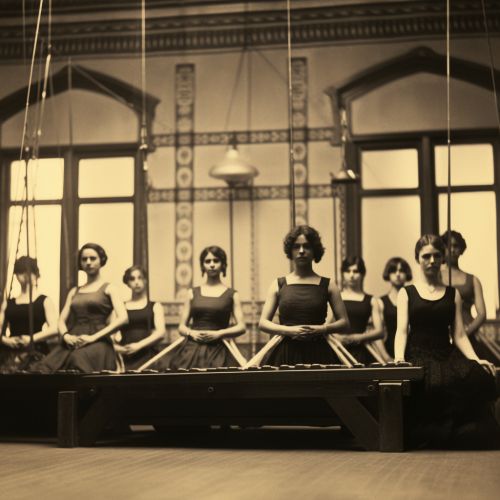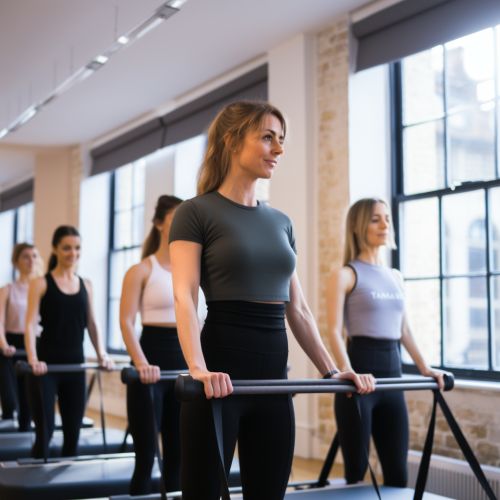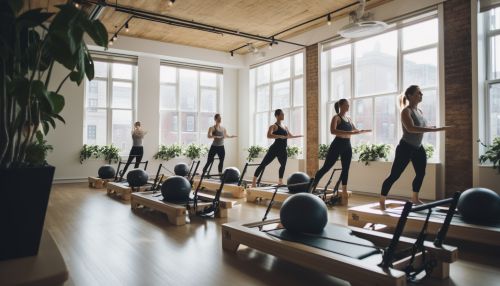Pilates
History
Pilates is a physical fitness system developed in the early 20th century by Joseph Hubertus Pilates, after whom it was named. Pilates called his method "Contrology," referring to the way the method encourages the use of the mind to control the muscles. The program focuses on the core postural muscles which help keep the body balanced and which are essential to providing support for the spine.


Joseph Pilates was born in Germany in 1883. As a child, he suffered from several diseases that led him to develop a method of exercise and lifestyle that emphasized balance, strength, flexibility, and overall wellness. His method was influenced by western forms of exercise, including boxing and gymnastics, as well as eastern forms, such as yoga and tai chi.
Principles
There are six key principles of Pilates: Centering, Concentration, Control, Precision, Breath, and Flow. These principles are considered the foundation of the Pilates approach to exercise. Their application to the Pilates method of exercise is part of what makes it unique in the fitness world.
Centering
The concept of centering relates to the physical center of the body – the area between the lower ribs and pubic bone. All Pilates exercises are sourced from this center, often referred to as the "powerhouse".
Concentration
In Pilates, the way in which the exercises are done is of equal importance to the exercises themselves. This principle relates to the full attention required to perform each exercise with total commitment and to maximize its value.
Control
Control, or "Contrology" as Joseph Pilates referred to it, is about muscle control. Every Pilates exercise is done with complete muscular control. No body part is left to its own devices.
Precision
Precision is essential in Pilates. The focus is on doing one precise and perfect movement, rather than many half-hearted ones. Here, the goal is for this precision to eventually become second nature, and carry over into everyday life as grace and economy of movement.
Breath
Breath is the life force. In Pilates, full and thorough inhalation and exhalation are part of every movement. The act of breathing fully and deeply provides a rhythm for the exercises, helping practitioners to execute movements with power and efficiency.
Flow
Flow, or fluidity, is the goal of all Pilates exercises. The exercises are intended to flow within and into each other in order to build strength and stamina. This is why Pilates is often seen as a movement system, not just a set of exercises.


Benefits
Pilates has been found to improve flexibility, build strength and develop control and endurance in the entire body. It puts emphasis on alignment, breathing, developing a strong core, and improving coordination and balance.
The benefits of Pilates include improved muscle tone and strength, particularly of your abdominal muscles, lower back, hips and buttocks (the 'core muscles' of your body), balanced muscular strength on both sides of your body, enhanced muscular control of your back and limbs, improved stabilization of your spine, improved posture, rehabilitation or prevention of injuries related to muscle imbalances, and increased lung capacity and circulation through deep breathing.
Equipment
Pilates exercises are performed on a mat or on specialized equipment, such as the Reformer, the Cadillac, and Wunda Chair. With its system of pulleys and springs, handles and straps, the apparatus can provide either resistance or support, depending on your needs.


Mat Pilates
Mat Pilates is a series of exercises from within the Pilates Method designed to be performed on a mat. Although Pilates always emphasizes quality of movement over quantity of repetitions, many consider Mat Pilates to be the hardest part of the Pilates method to master.
Reformer Pilates
The Reformer is the main piece of equipment used in Pilates exercise. The Reformer glides forward and backward on rollers and uses springs for resistance, along with other attachments, for a wide variety of exercises and positions (i.e. lying down, seated, standing).
Cadillac
The Cadillac, also known as the Trapeze Table, is one of the most effective and versatile pieces of exercise equipment. The Cadillac was originally devised by Joseph Pilates to rehabilitate bedridden patients back when he was working as a hospital orderly.
Wunda Chair
The Wunda Chair is a piece of Pilates equipment designed by Joseph Pilates. It is a small piece of equipment, which makes it a versatile piece for Pilates exercises and a great addition to a Pilates home gym.
